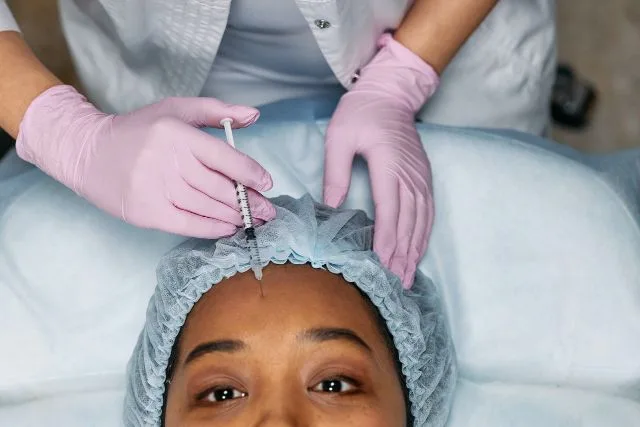Maintaining youthful good looks can feel like a full-time job, with many women (and men) now opting for non-surgical rejuvenation treatments like botulinum toxin or dermal fillers, as part of their long-term beauty planning.
Botulinum Toxin vs. Dermal Fillers: Which Works Best?
Well, that depends on what your needs are. In this article, I offer my insights and guidance on both treatments, looking at what they’re used for and advising what you should ask your doctor before getting either.
Understanding the product
While often referred to interchangeably, botulinum toxin and dermal fillers are not the same thing. Let’s start with botulinum toxin. The first thing you would need to know is that Botox® is a brand of botulinum toxin and not a treatment.
Botulinum toxin is made from a toxin produced by the bacterium Clostridium botulinum. The Cleveland Clinic describes botulinum toxin as a neuromodulator that, in small doses, can block nerves, causing the injected muscles to weaken and decrease the formation of wrinkles.
Interestingly, it is also frequently used to treat migraines, eye twitches, hyperhidrosis (or excessive sweating), and pain caused by temporomandibular joint disorders such as clenching or grinding one’s teeth.
Dermal fillers, on the other hand, are purely cosmetic. These liquid implants are made from a synthetic material like hyaluronic acid or polymethylmethacrylate and are injected into the skin, the fatty layers, and just above the bone, but not the muscles.
Different products for different areas
Botulinum toxin is better suited to treat lines or wrinkles that are caused by the repetitive movement of our facial expressions like the frown, crow’s feet, and forehead.
Dermal fillers, meanwhile, are used to fill lines and folds, increase volume when one has thinned lips with aging, and lift facial structures, including the eyebrows and jowl. Soft tissue fillers can also redefine lost shape such as the jawline or chin.
Botulinum toxin can be used to treat:
- Forehead lines
- The “11s” (or glabellar lines) between your eyebrows
- Crow’s feet around the eyes
- Static wrinkles caused by repetitive facial expression – lines and folds on the face that are visible when your face is resting or expressionless.
Dermal fillers can be used to treat:
- Smile lines, vertical or lipstick lip lines, chin wrinkles, and acne scars
- Redefining the jaw or chin
- lifting facial structures like the jowl, neck, and eyebrows
- Increasing the volume of lips
- Improving the appearance of under-eye bags
The different types of dermal fillers include:
- Hyaluronic Acid (HA) is naturally found inside the body and is excellent for reducing depressions in the skin, such as those created from acne scars. It can also improve the skin’s contours and typically lasts from twelve to 18 months.
- Calcium hydroxyapatite is a “stimulating” type of filler that can be used to enhance cheek fullness and smoothing out frown lines.
- Poly-L-lactic acid is also a “stimulating” type of filler. As the name suggests, it stimulates the face to produce collagen that helps to improve the condition of the skin. It can last up to two years.
- Combination fillers include both HA and Calcium Hydroxyapatite (CH) to produce a volumizing and lifting effect with the HA, and a stimulatory collagen effect with the CH.
The best of both worlds
To achieve the best results, one should consider combining botulinum toxin with soft tissue fillers. So, in most cases, both treatment options can be considered.
Exceptions include a young patient who does not need any fillers but would like to start a preventative botulinum treatment regime or someone who is wrinkle-free but has a genetic anatomical problem such as a thin upper or lower lip or flat cheeks. In these cases, a single specific treatment will be recommended.
What would you like to achieve?
I advise prospective patients to ask themselves the following questions about what they are hoping to accomplish
- If you look in the mirror, are there any areas you would like to improve?
- Looking in the mirror, do you notice any specific ‘emotion’ like tiredness (bags under the eyes)? Or gauntness, sadness (drooping corners of the mouth), or saggy (visible jowling or loss of jaw definition)?
- Do your friends ask you what is wrong, or why are you so tired, why do you look cross, etc.?
Questions to ask your doctor
While both botulinum toxin and dermal fillers are non-surgical procedures, they have to be done by a professional.
Any mistakes can lead to temporary disfigurement (by injecting the wrong muscle), or lumpiness, infections, and unwanted results, at the injection site in the case of dermal fillers, for example.
It is important to determine whether your doctor is qualified. You should also ensure that you are aware of the costs involved before committing to a treatment plan.
How long does it last?
Botulinum toxin lasts four months on average, though regular users can see results for up to six months. Fillers are a longer-term commitment lasting between twelve months and two years.
To learn more about botulinum toxin and dermal fillers click here.



![women [longevity live]](https://longevitylive.com/wp-content/uploads/2020/01/photo-of-women-walking-down-the-street-1116984-100x100.jpg)










